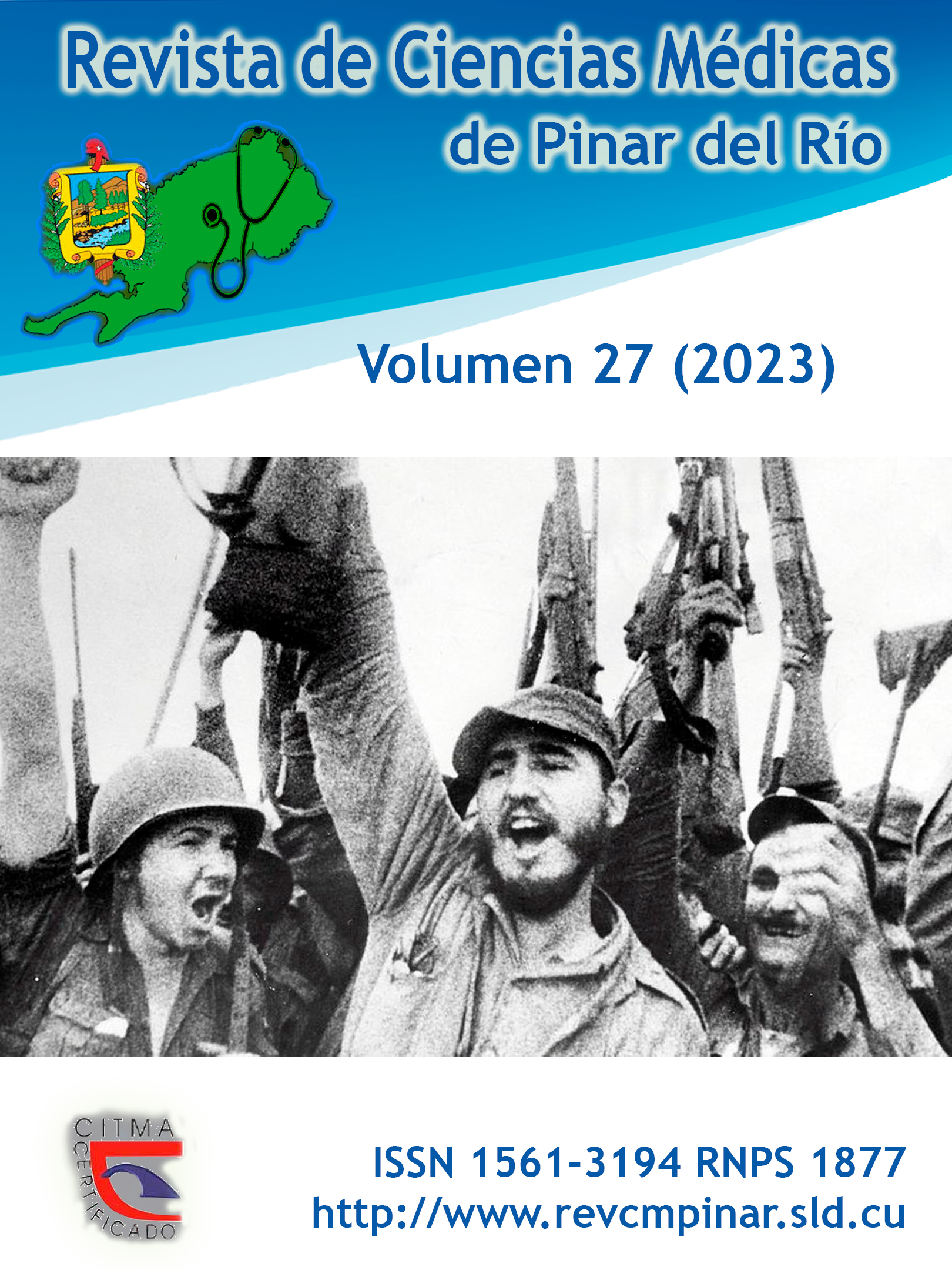Virtual courses as spaces for the exchange of knowledge
Keywords:
COVID-19, COURSES, LONG DISTANCE EDUCATION, INFORMATION TECHNOLOGY.Abstract
Introduction: as technological development advances by leaps and bounds, virtual and interactive spaces occupy more and more time in man's daily life. The use of information and communication technologies are necessary tools to cope with the high flow of information that is handled.
Objective: to describe the impact of virtual pre-event courses belonging to CovidCien2021 on medical science students.
Methods: an observational, descriptive and cross-sectional study was carried out. The universe consisted of 53 students. We worked with the entire universe; no sampling technique was used. Variables: number of courses and participants per course, age, sex, academic year, career and polytomous variables. Descriptive and percentage statistics were used.
Results: 12 courses were given, with an average of 173 participants. The female sex stood out with 36 participants (67,92 %). The fourth academic year (19; 35,84 %) and the medical career (45; 84,90 %) stood out. The mean number of responses was 253,57; there was general satisfaction among the participants. The highest number of responses were in the category totally satisfied.
Conclusions: the development of courses through virtual spaces offers notable alternatives and benefits. It is presented as a renovating alternative in the face of complex situations that guarantees the continuity of teacher training. Its organization and implementation should not be schematized to a specific sector or subject of knowledge, but should be diversified, without losing sight of the presence as a key element.
Downloads
References
1. del Castillo Saiz GD, Sanjuán Gómez G, Gómez Martínez M. Tecnologías de la Información y las Comunicaciones: desafío que enfrenta la universidad de ciencias médicas. EDUMECENTRO [Internet]. 2018 [citado 24/12/2021]; 10(1): 168-182. Disponible en: http://www.revedumecentro.sld.cu/index.php/edumc/article/view/908
2. Vergara de la Rosa E, Vergara Tam R, Alvarez Vargas M, Camacho Saavedra L, Galvez Olortegui J. Educación médica a distancia en tiempos de COVID-19. Edu Med Sup [Internet]. 2020 [citado 24/12/2021]; 34(2): e2383. Disponible en: http://www.ems.sld.cu/index.php/ems/article/view/2383
3. Jiménez Franco LE, Díaz Jiménez L. Fidel Castro Ruz: paradigma de la formación del estudiante de las ciencias médicas. HolCien [Internet]. 2021 [citado 24/12/2021]; 2(3): 1-16. Disponible en: http://www.revholcien.sld.cu/index.php/holcien/article/view/83
4. Jiménez-Franco L, Diaz-de-la-Rosa C, Quintero-Méndez Y. Primera Jornada Científica Nacional Virtual sobre COVID-19 y Simposio Nacional Virtual sobre atención al paciente grave y crítico con COVID-19: espacios para el intercambio de conocimientos. Medisur [Internet]. 2022 [citado 08/12/2021]; 20(1): 1-3. Disponible en: http://www.medisur.sld.cu/index.php/medisur/article/view/5314
5. Ospina Rave BE, de Jesús Sandoval J, Aristizábal Botero CA, Ramírez Gómez MC. La escala de Likert en la valoración de los conocimientos y las actitudes de los profesionales de enfermería en el cuidado de la salud. Antioquia, 2003a. Investigación y Educación en Enfermería [Internet]. 2005 [citado 23/12/2021]; 23(1): 14-29. Disponible en: https://www.redalyc.org/pdf/1052/105215401002.pdf
6. Benítez-Rojas LdlC. Ciencia estudiantil: Eventos Científicos Estudiantiles Virtuales durante la COVID-19. Univ Méd Pinareña [Internet]. 2021 [citado: 24/12/2021]; 17(3): e622. Disponible en: http://www.revgaleno.sld.cu/index.php/ump/article/view/622
7. San-Juan-Bosch M, García-Núñez R, Mur-Villar N, Falcón-Hernández A, Díaz-Brito A. Experiencias y alternativas académicas de la Universidad de Ciencias Médicas de Cienfuegos durante la COVID-19. Medisur [Internet]. 2020 [citado 24/12/2021]; 18(3): 1-5. Disponible en: http://medisur.sld.cu/index.php/medisur/article/view/4712
8. Díaz Cuéllar FE, Castro Gutiérrez E, Torres Cancino I, Castro Alonso M, González Flores G. Diagnóstico del uso de las TIC’s como recurso de aprendizaje en los estudiantes de Pregrado en la Facultad de Ciencias Médicas de Matanzas. Rev. Med Electr [Internet]. 2020 [citado 24/12/2021]; 42(5): 1-14. Disponible en: http://revmedicaelectronica.sld.cu/index.php/rme/article/view/3698
9. Hernández-García F, Robaina-Castillo JI, Lazo Herrera LA, Sorí Peña JA, Hidalgo Ávila M, Pérez Calleja NC, et al. Plataforma digital para la satisfacción de las necesidades informacionales sobre la actividad científica estudiantil en Ciencias Médicas. RCICS [Internet]. 2020 [citado 24/12/2021]; 31(2): e1455. Disponible en: http://scielo.sld.cu/scielo.php?script=sci_arttext&pid=S2307-21132020000200012&lng=es&nrm=iso&tlng=es
10. Alvarado Chávez TS, Velez Alban RV, Benavides Naranjo RA, Andrade Macías JB. Las TICS como herramientas en la formación del pre y posgrado de la Facultad de Ciencias Médicas de la UEES. RECIMUNDO [Internet]. 2020 [citado 24/12/2021]; 4(1): 1-19. Disponible en: http://recimundo.com/index.php/es/article/view/763
11. Barragán-Saldaña EA, Verdugo-Ortiz VM, Quinto-Ochoa ED. El uso de las TICS en el mejoramiento y su incidencia en los procesos enseñanza aprendizaje. Dom. Cien [Internet]. 2017 [citado 24/12/2021]; 3(2): 138-162. Disponible en: http://dominiodelasciencias.com/ojs/index.php/es/index
Downloads
Published
How to Cite
Issue
Section
License
Authors who have publications with this journal agree to the following terms: Authors will retain their copyrights and grant the journal the right of first publication of their work, which will be publication of their work, which will be simultaneously subject to the Creative Commons Attribution License (CC-BY-NC 4.0) that allows third parties to share the work as long as its author and first publication in this journal are indicated.
Authors may adopt other non-exclusive license agreements for distribution of the published version of the work (e.g.: deposit it in an institutional telematic archive or publish it in a volume). Likewise, and according to the recommendations of the Medical Sciences Editorial (ECIMED), authors must declare in each article their contribution according to the CRediT taxonomy (contributor roles). This taxonomy includes 14 roles, which can be used to represent the tasks typically performed by contributors in scientific academic production. It should be consulted in monograph) whenever initial publication in this journal is indicated. Authors are allowed and encouraged to disseminate their work through the Internet (e.g., in institutional telematic archives or on their web page) before and during the submission process, which may produce interesting exchanges and increase citations of the published work. (See The effect of open access). https://casrai.org/credit/



